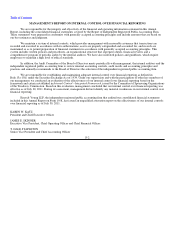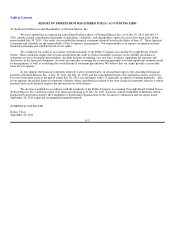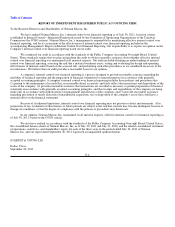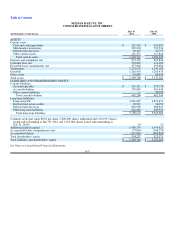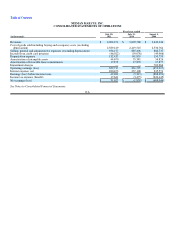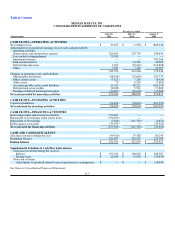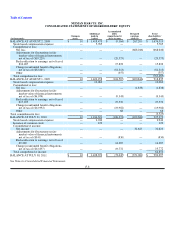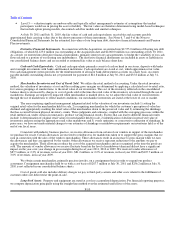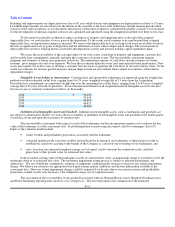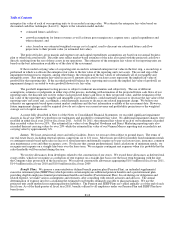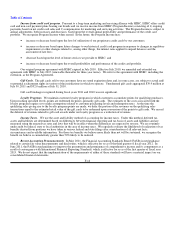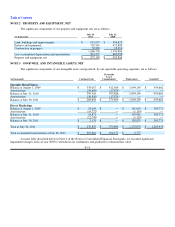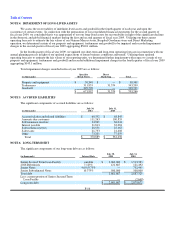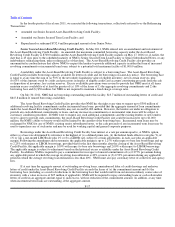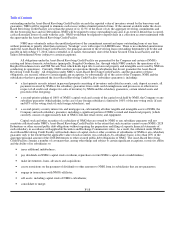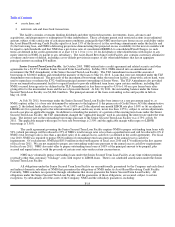Neiman Marcus 2010 Annual Report Download - page 107
Download and view the complete annual report
Please find page 107 of the 2010 Neiman Marcus annual report below. You can navigate through the pages in the report by either clicking on the pages listed below, or by using the keyword search tool below to find specific information within the annual report.
Table of Contents
Buildings and improvements are depreciated over five to 30 years while fixtures and equipment are depreciated over three to 15 years.
Leasehold improvements are amortized over the shorter of the asset life or the lease term (which may include renewal periods when
exercise of the renewal option is at our discretion and exercise of the renewal option is considered reasonably assured). Costs incurred
for the development of internal computer software are capitalized and amortized using the straight-line method over three to ten years.
To the extent we remodel or otherwise replace or dispose of property and equipment prior to the end of the assigned
depreciable lives, we could realize a loss or gain on the disposition. To the extent assets continue to be used beyond their assigned
depreciable lives, no depreciation expense is incurred. We reassess the depreciable lives of our long-lived assets in an effort to reduce
the risk of significant losses or gains at disposition and the utilization of assets with no depreciation charges. The reassessment of
depreciable lives involves utilizing historical remodel and disposition activity and forward-looking capital expenditure plans.
We assess the recoverability of the carrying values of our store assets, consisting of property and equipment, customer lists
and favorable lease commitments, annually and upon the occurrence of certain events. The recoverability assessment requires
judgment and estimates of future store generated cash flows. The underlying estimates of cash flows include estimates for future
revenues, gross margin rates and store expenses. We base these estimates upon the stores' past and expected future performance. New
stores may require two to five years to develop a customer base necessary to generate the cash flows of our more mature stores. To the
extent our estimates for revenue growth and gross margin improvement are not realized, future annual assessments could result in
impairment charges.
Intangible Assets Subject to Amortization. Customer lists and amortizable tradenames are amortized using the straight-line
method over their estimated useful lives, ranging from 4 to 24 years (weighted average life of 13 years from the Acquisition).
Favorable lease commitments are amortized straight-line over the remaining lives of the leases, ranging from 9 to 49 years (weighted
average life of 33 years from the Acquisition). Total estimated amortization of all Acquisition-related intangible assets for the next
five fiscal years is currently estimated as follows (in thousands):
2012 $ 50,123
2013 47,436
2014 46,881
2015 46,615
2016 40,484
Indefinite-Lived Intangible Assets and Goodwill. Indefinite-lived intangible assets, such as tradenames and goodwill, are
not subject to amortization. Rather, we assess the recoverability of indefinite-lived intangible assets and goodwill in the fourth quarter
of each fiscal year and upon the occurrence of certain events.
The recoverability assessment with respect to each of the tradenames used in our operations requires us to estimate the fair
value of the tradename as of the assessment date. Such determination is made using discounted cash flow techniques (Level 3).
Inputs to the valuation model include:
• future revenue and profitability projections associated with the tradename;
• estimated market royalty rates that could be derived from the licensing of our tradenames to third parties in order to
establish the cash flows accruing to the benefit of the Company as a result of our ownership of our tradenames; and
• rates, based on our estimated weighted average cost of capital, used to discount the estimated royalty cash flow
projections to their present value (or estimated fair value).
If the recorded carrying value of the tradename exceeds its estimated fair value, an impairment charge is recorded to write the
tradename down to its estimated fair value. The tradename impairment testing process is subject to inherent uncertainties and
subjectivity. The use of different assumptions, estimates or judgments could materially increase or decrease any related impairment
charge. We believe our estimates are appropriate based upon current market conditions and the best information available at the
assessment date. However, future impairment charges could be required if we do not achieve our current revenue and profitability
projections, market royalty rates decrease or the weighted average cost of capital increases.
The assessment of the recoverability of the goodwill associated with our Neiman Marcus stores, Bergdorf Goodman stores
and Direct Marketing reporting units involves a two-step process. The first step requires the comparison of the estimated
F-11



